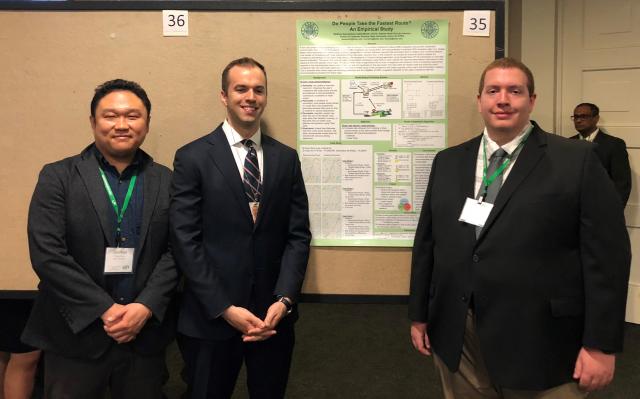Computer Science Research Project Takes Kean Students to Capitol Hill

Kean computer science graduate student Matthew Seesselberg, at far right, was lead presenter at the Posters on the Hill research conference in Washington, D.C. With him are faculty advisor Daehan Kwak, Ph.D., assistant professor at Kean's School of Computer Science, at far left; and a staff member from U.S. Rep. Thomas Malinowski's office.
A Kean computer science student’s commuting routine put him on the road to Capitol Hill, when a research project conducted by him and a partner was included in the prestigious “Posters on the Hill” conference in Washington, D.C.
The project, “Do People Take the Fastest Route? An Empirical Study,” explored the question of whether a driving route recommended by Google Maps is faster than a driver’s personal choice of route.
Student researchers Matthew Seesselberg and Isabel Morais, both of whom graduated in May with B.S. degrees in computer science, conducted research under the advisement of Professor Daehan Kwak, Ph.D. Seeselberg got the idea for the project after driving back and forth to Kean.
The poster was one of 60 selected, from 350 submitted, to be presented at the event in Washington, D.C. hosted by the Council on Undergraduate Research.
“This event helps members of Congress understand the importance of undergraduate research by directly interacting with students. This venue is highly competitive. Being selected as one of the best from around the nation is a great honor to the students and myself,” Kwak said.
In Washington, the Kean team met with staff from the offices of U.S. Reps. Thomas Malinowski and Frank Pallone to discuss the project and Kean research overall.
Kean actively encourages students to take part in research through its annual Research Days, and with the support of its Office of Research and Sponsored Programs.
Kean President Dawood Farahi, Ph.D., said research opportunities are something that sets Kean apart. “Research enriches the learning environment, and Kean actively encourages students to explore questions and further their education through research,” he said.
Seesselberg, who commuted to Kean from his home in Edison, said he wanted to find out if following Google Maps’ route is better, even if a driver’s hunch is to go a different way. The student researchers built a system to show how much a driver’s selected route corresponded to the recommended route in Google maps, and if the user did not take the Google maps-recommended route, what would be the time loss or gain.
“From our findings, the recommended route was found to be the faster route, despite not always being the shortest distance,” said Seesselberg, who served as lead presenter.
The students also presented this spring at Kean’s Research Days, where Morais was selected as Kean’s Undergraduate Researcher of the Year. After graduation, Morais took a position in the automotive industry and Seesselberg is pursuing his master’s degree in computer information systems at Kean.
Kwak thanked the students for their hard work. “Kean’s School of Computer Science has a diverse student body and hard-working faculty members who do their best to promote research,” he said. “I would advise other students to take on the adventure of exploring problems through research.”